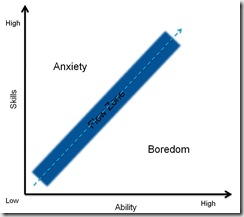At the SPA conference recently, Joseph Pelrine talked about “Flow: The Psychology of Optimal Experience” by Mihalyi Czikszentmihalyi. The ideas behind this struck a chord with me as a way of describing something I originally said when discussing whether kanban is only suitable for mature teams. That is that rather than focusing on being Agile which may (and should) lead to being successful, Kanban focuses on becoming successful, which may lead to being Agile.
Mihalyi Czikszentmihalyi describes the state of Flow as having a balance between ability, and the skills required for a piece of work. If some work requires more skill than a person has ability, then they are in a state of Anxiety. If a person has more ability than the skills required for a some work then they are in a state of Boredom. Applying this to Process Improvement, we want to move teams up the Flow Zone so that skills required and ability increase equally.
Increasing Skills and Ability equally at the same time is unlikely, so in practice there are two routes to move up the Flow Zone. The first is what I am dubbing “Anxiety Driven Process Improvement”. Move a team into a state of Anxiety such that they need to improve their skills to cope. I assert that this is the approach that makes time-box based method so effective. Time-boxing forces teams into a place where they need to improve their skills in order to deliver working software every few weeks. Many teams push back, and a common approach to this is to make the time-box shorter to emphasis the point! The other route is to do “Boredom Driven Process Improvement”. Highlight to the teams where they need to improve their ability, and allow and support them in doing so such that they are able to taken on work requiring more skill. I further assert that this is the approach that kanban systems take. Visualising queues and work in progress in order expose the bottleneck where the ability needs improving.
This might sound like I am suggesting the time-boxing and kanban are mutually exclusive approaches. That isn’t the case – I have already said that! Instead, I just find it an interesting angle to look at a different dynamic between two approaches.



[…] Anxiety or Boredom Driven Process Improvement? (Karl Scotland) […]
Very interesting! Thanks for posting about this.
In thinking about my approach to team improvement, I use both sides of this. In the beginning, I lean more on the anxiety side of things: timeboxing, external pressure, exposed demand. However, I try to do it in such a way that people regularly experience flow. Once they develop a taste for it, once successful delivery of software become an enjoyable norm, I back off, and let boredom take over as a larger motivating factor. Flow is wonderfully addictive.
I think any sustainable approach has to maintain structures for both sorts of motivation in measured amounts. Excess boredom leads to disengagement, taking people off the flow curve in a way that’s hard to reawaken purely through being supportive. Excess anxiety leads to eventual exhaustion and aversion, which cannot be remedied except through time and patient support. I see long-running teams bumping up against both fear and boredom as they climb the skill/challenge line.
That’s certainly true in my own life. For example, fear about health is what got me to start regular exercise, and what brings me back after lapses. But what keeps me going and working to improve is boredom. Hooray for both of them!
This exemplifies the situation at my current client’s office. Due to the small size of the team and the lack of process, and other factors, individuals have fallen into the boredom and fear driven development. Timeboxing will allow more flow for both, not just fear-driven.